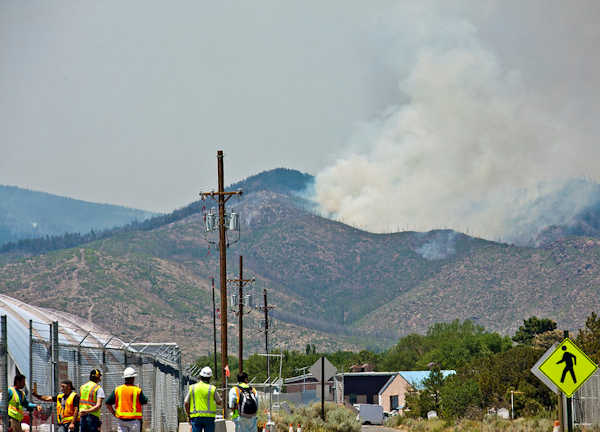SEJournal Online is the digital news magazine of the Society of Environmental Journalists. Learn more about SEJournal Online, including submission, subscription and advertising information.
 |
| In an example of how extreme weather can threaten hazardous waste sites, workers watch the Las Conchas fire near a waste cleanup site at Los Alamos National Laboratory in July 2011. Photo: U.S. Department of Energy (United States government work). |
TipSheet: When Extreme Weather Amplifies Hazardous Waste Threats
By Joseph A. Davis
Toxic waste sites these days are refusing to stay put as extreme weather challenges them. Floods, storms, drought, wildfire, heat and other weather cataclysms often stir up toxic trouble at sites some people hoped were “cleaned up” or managed.
As weather extremes get worse with climate heating, it’s more often an issue … an overlooked issue.
So wherever you are, don’t forget about these hot spots. One of them may soon be making news near you.
Why it matters
A wide variety of bad and ugly stuff is buried at hazardous waste sites. Some of it may be acutely or chronically toxic, explosive, flammable, corrosive, radioactive or harmful in other ways.
In other words, it is almost by definition harmful to human health and the environment.
Other hazards may be less obvious (which is why we have environmental journalists). Hazardous materials may find their way into groundwater that people drink, for example. Or they may be swept away or relocated by floods — to somewhere less wary of them.
Nowadays, as well, the increase in wildfires may create huge threats, especially when the fires put ground-bound hazardous materials into air that people may breathe across multistate lines.
These are not harms we can or should endure — but real protection and cleanup is often hard to come by.
The backstory
Before Congress passed laws to control the worst toxic dumping, there was already a vast legacy of forgotten sites, often filled with rusting barrels of unknown chemicals that made people sick. Some are still there. Some are in places nobody would look for them, like the bottom of the sea (may require subscription).
After Hurricane Harvey dumped up to 5 feet of rain on the Houston area in 2017, the Associated Press did a story on Superfund sites at risk of having hazardous waste mobilized by the water. The Trump Environmental Protection Agency press office personally attacked (may require subscription) the AP reporters, alleging untruths in the process.
Thing is: The AP was factually correct. And went on to pursue the story in larger contexts. And call out Trump EPA untruths.
Concern over extreme weather
mobilizing hazardous waste can
go well beyond Superfund sites.
Concern over extreme weather mobilizing hazardous waste can go well beyond Superfund sites. In 2011, wildfire threatened Los Alamos National Lab in New Mexico — where some nuclear waste was still uncontained. Disaster was averted that time. But even in the last few years, the concern remains unaddressed.
It’s worth remembering that not all sites on the Superfund National Priorities List have been completely cleaned up yet. Some are on very long timelines. Some are very large.
An example is the large Tar Creek site in northeastern Oklahoma, which was listed in 1983. Recently, residents have blamed the operation of a local dam for making things worse with flooding.
Story ideas
- Take a look at the Superfund National Priorities List, and find the worst sites near you. If they are still on the list, they probably haven’t been fully cleaned up. What threats do/did they present? Would extreme weather amplify such threats?
- Look for the dangerous waste sites near you that are not on the national Superfund list. Did you know there’s a bigger list of such sites? It’s called the Superfund Active Site Inventory. EPA screens these sites methodically. Look for more lists here.
- What are the extreme weather threats affecting your area? What would abnormal flooding do? Hurricane or tornado winds? Wildfire worse than historical memory? What dust would be mobilized by severe drought?
Reporting resources
- Superfund National Priorities List: This is EPA’s official list of the worst toxic and hazardous waste sites nationwide. There are usually more than 1,300 of them.
- State-level hazardous waste site lists: State agencies often keep their own hazardous waste site lists.
- EPA brownfields lists: Explore a searchable database of brownfields grant recipients.
- Center for Health, Environment and Justice: A nonprofit advocacy group founded by Lois Gibbs, whose organizing brought us the cleanup of Love Canal and eventually the Superfund.
- EPA Permitting Databases: Legal permits under the Resource Conservation and Recovery Act can be a starting point. Try others, too, such as coal ash sites.
- EJToday headlines: Check out the latest Superfund and hazmat-related news from our EJToday weekday news aggregation service.
Joseph A. Davis is a freelance writer/editor in Washington, D.C. who has been writing about the environment since 1976. He writes SEJournal Online's TipSheet, Reporter's Toolbox and Issue Backgrounder, and curates SEJ's weekday news headlines service EJToday and @EJTodayNews. Davis also directs SEJ's Freedom of Information Project and writes the WatchDog opinion column.
* From the weekly news magazine SEJournal Online, Vol. 8, No. 20. Content from each new issue of SEJournal Online is available to the public via the SEJournal Online main page. Subscribe to the e-newsletter here. And see past issues of the SEJournal archived here.














 Advertisement
Advertisement 



